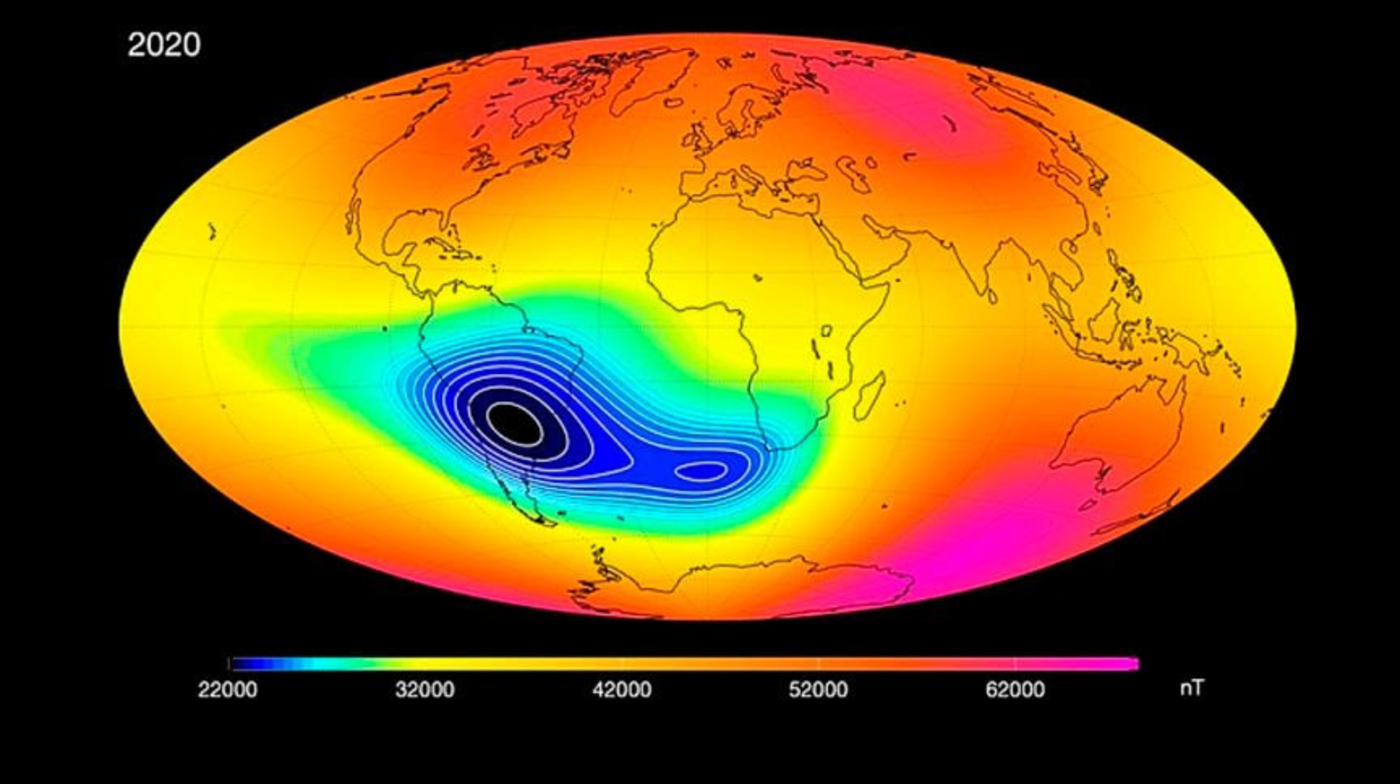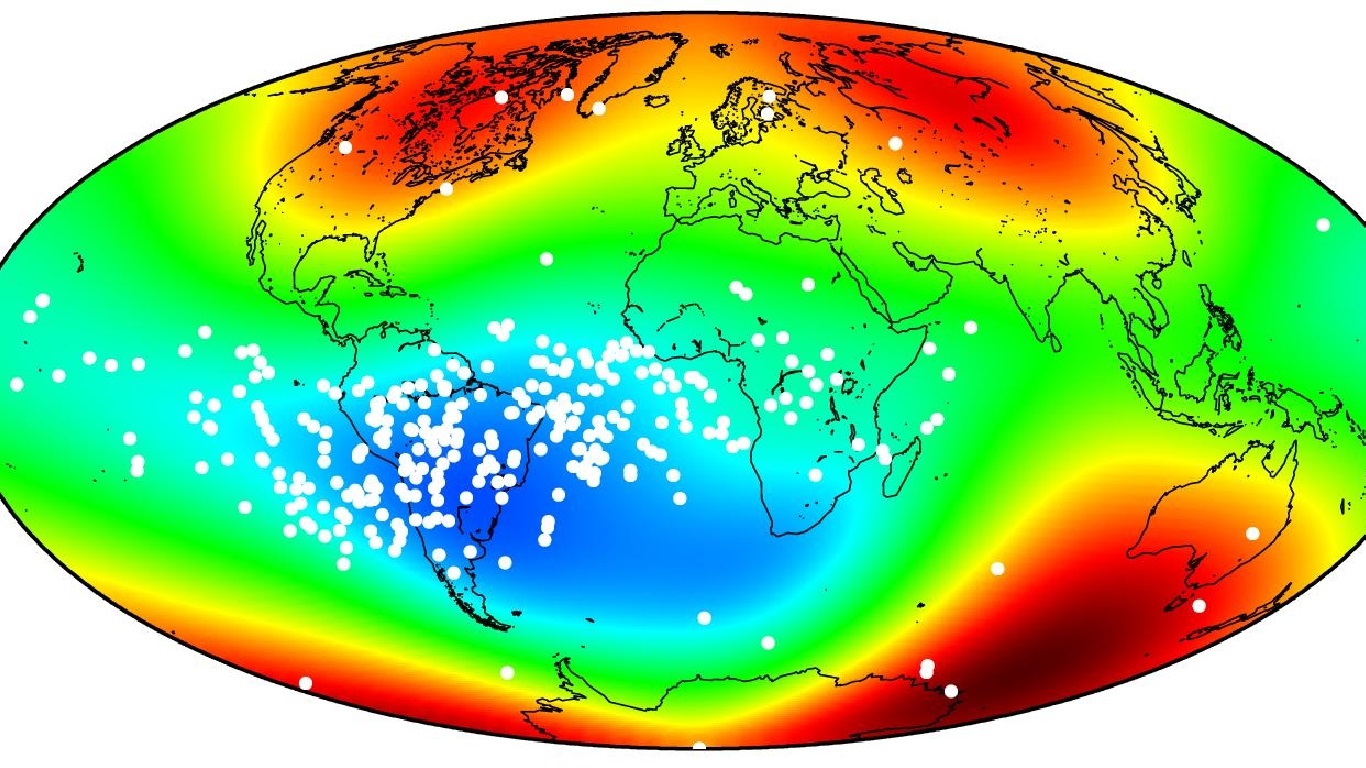A magnetic anomaly is growing in the South Atlantic Ocean, according to data that appeared in The latest US government report published this year. The so-called Atlantic Magnetic Anomaly (AMAS) is a place in the South Atlantic Ocean where the magnetosphere that surrounds our planet is at its weakest.
ESA
This anomaly is monitored by several intergovernmental agencies that make up the World Magnetic Model (WMM), a “harmonic spherical model of Earth’s main magnetic field and its slow temporal variation.”
These institutions include the Intelligence Agency (NGA) and the UK’s Defense Geographical Center (DGC), based on information developed by the British Geological Survey (BGS) and the US National Centers for Environmental Information (NCEI), which are responsible for monitoring the largest collection of files containing Information about atmospheric, oceanic, coastal and geophysical data from the Earth’s surface, as well as from the bottom of its crust, which extends into the planet’s core.
Our planet’s geomagnetic field is subject to constant changes caused by activity in the Earth’s core, which current models cannot easily predict. For this reason, the global magnetic model can only give a good estimate of Earth’s short-term geomagnetic activity over time and must be updated every five years or so.
According to the latest edition of the report, comparisons of data from data dating back to 2019 with more recent data made available by the European Space Agency (ESA) and its Swarm satellites conclude that current models are still accurate. However, the new report also details what scientists describe as a “deepening” of a magnetic anomaly in the South Atlantic. NASA too.
“The anomaly is deepening and moving west,” the authors say in the report. The “affected area,” say the authors, “has increased by about 5% in this period. This contour approaches the area where radiation damage to satellites is most likely to occur.”

Height and location of the South Atlantic Anomaly between 2019 and 2023 | NCII/NOAA
According to the report, the anomaly still affected in many ways, from possible damage to satellites due to excessive radiation, to obstruction of the propagation of radio waves. While the report’s authors also note that AMAS is believed to affect the polar regions, they add that “the effects depend less on field strength.”
Unlike Mercury, Venus, and Mars, the Earth is surrounded by a massive magnetic field called the magnetosphere. The magnetosphere, created by dynamic and powerful forces at the center of our universe, protects us from the erosion of our atmosphere by solar winds (charged particles constantly thrown out by our sun), erosion and particle radiation from coronal mass ejections (massive clouds of energy, magnetized solar plasma and radiation) and cosmic rays from deep space .
The magnetosphere acts as a gatekeeper, expelling this unwanted energy that is harmful to life on Earth, keeping most of it safely off Earth’s surface in twin donut-shaped regions called the Van Allen belts.
What catches the eye is the abbreviation AMAS which means Magnetic anomalies in the South Atlantic Ocean. It is a phenomenon that remains a mystery to science and it is not uncommon on social networks for someone to wonder if they will not interfere with the climate in Brazil and South America, although there is no evidence yet.

NOAA/Disclosure
AMAS, which is growing and has its center closer to South America, is a type of lag in the magnetic protection of the Earth located over the South Atlantic Ocean, more specifically in the southern and southeastern regions of Brazil, in a range extending into Africa.
But how might this lack of protection over the South Atlantic affect life on our planet? One consequence that we already understand is the performance of satellites in Earth’s orbit. When passing through the area with low back protection, a glitch caused by the cosmic radiation flux may occur.
Therefore, the anomaly is being monitored by space agencies such as the European Space Agency and NASA, and more recently by Brazil, which launched the NanosatC-BR2 nanosatellite into space with this mission. This is what Marcel Nogueira, Doctor of Physics and Researcher at the National Observatory, explained to Agência Brasil.
Why are space agencies interested in this anomaly? Since this region has a weaker field, solar wind particles enter this region more easily, the flow of charged particles that pass through that region is more intense,” Nogueira explains.
“This means that when satellites pass through this area, they sometimes have to stay on standby, and temporarily unplug some components to avoid losing the satellite, or any equipment that might burn up. Because the radiation, especially the electrons, in this area is very strong. So it is in the interest of Space agencies should constantly monitor the development of this anomaly, particularly in this central band,” he adds.
Imagine a day without internet, cell phone, GPS or communications? If the phenomenon affects the satellites responsible for communication and geolocation systems, it can affect our very technological lives.
“If we also study storms, we can improve and protect the electricity distribution system, and avoid blackouts. Because in our daily life today, depending heavily on technology, any kind of blackout in the electrical system, in any country, generates losses of millions or even billions of dollars. Researcher says it is something very important for our technological life nowadays.
In Brazil, in addition to the nanosatellite launched into space in partnership with the Russian Space Agency, there are also two magnetic observatories that focus, among other tasks, on answering questions about this anomaly: Fasoras, in Rio de Janeiro, and Tatoka. , in the Amazon region.
Both are part of the global network of magnetic observatories, Intermagnet. The lack of conclusions raises curiosity about the South Atlantic Anomaly. This is why it is popularly associated with events such as those already recorded in the Bermuda Triangle. But Marcel prefers to say that this phenomenon is much more technically challenging and that there are no conclusions that point to the dangers of the cosmic radiation flux in human life.

“Incurable thinker. Food aficionado. Subtly charming alcohol scholar. Pop culture advocate.”






More Stories
NASA Releases Selfie of Perseverance Rover Working on Mars
NVIDIA driver includes hidden Final Fantasy XVI profile
PlayStation Plus Extra and Premium saw a significant drop in players in July